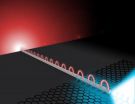(Press-News.org) The way in which some cells alter their behaviour at the onset of osteoarthritis has been identified for the first time by researchers at the University of Liverpool.
The study was funded by medical research charity Arthritis Research UK.
The trigger for arthritis is still to be fully defined, but it is known that injuries, obesity or old age can all increase the risk for arthritis, and lead to cells in the affected joint altering their behaviour.
The research team from the University's Institute of Ageing and Chronic Disease has now found that changes in the rate at which molecules in joint cartilage called mRNA are created and destroyed are fundamental to causing this change in behaviour.
These molecules act as a messenger – information from the DNA in cells is carried by mRNA to areas of the cells which create the proteins which carry out its function.
By upsetting this balance – with more mRNA being destroyed – the cells cease to function as effectively.
Senior lecturer in orthopaedic sciences, Dr Simon Tew said: "Osteoarthritic cartilage cells have a significant number of genes whose mRNA is destroyed more rapidly than those in healthy cells. This affects some genes that we already know are involved in osteoarthritis as well as some that are less well studied."
The researchers discovered this by comparing cells isolated from patients with osteoarthritis with those from healthy patients. The findings show how the cells in joints stop working properly, leading to arthritis and the researchers hope that by understanding this part of the process, new treatments can be developed which address the problem.
Dr Tew concluded: "We've not discovered the cause of arthritis, but this does shed light on the process of how the disease manifests itself. To develop new drugs to treat one of the leading causes of disability requires the fullest possible understanding of the condition and this discovery is part of that overall picture."
INFORMATION:
The study, 'Transcriptome wide analysis of mRNA decay in normal and osteoarthritic human articular chondrocytes,' is published in Arthritis and Rheumatism.
Messenger molecules identified as part of arthritis puzzle
2014-09-04
ELSE PRESS RELEASES FROM THIS DATE:
Researcher advances a new model for a cosmological enigma -- dark matter
2014-09-04
LAWRENCE — Astrophysicists believe that about 80 percent of the substance of our universe is made up of mysterious "dark matter" that can't be perceived by human senses or scientific instruments.
"Dark matter has not yet been detected in a lab. We infer about it from astronomical observations," said Mikhail Medvedev, professor of physics and astronomy at the University of Kansas, who has just published breakthrough research on dark matter that merited the cover of Physical Review Letters, the world's most prestigious journal of physics research.
Medvedev proposes a ...
Atomically thin material opens door for integrated nanophotonic circuits
2014-09-04
A new combination of materials can efficiently guide electricity and light along the same tiny wire, a finding that could be a step towards building computer chips capable of transporting digital information at the speed of light.
Reporting today in The Optical Society's (OSA) high-impact journal Optica, optical and material scientists at the University of Rochester and Swiss Federal Institute of Technology in Zurich describe a basic model circuit consisting of a silver nanowire and a single-layer flake of molybendum disulfide (MoS2).
Using a laser to excite electromagnetic ...
Trinity geologists re-write Earth's evolutionary history books
2014-09-04
Geologists from Trinity College Dublin have rewritten the evolutionary history books by finding that oxygen-producing life forms were present on Earth some 3 billion years ago – a full 60 million years earlier than previously thought. These life forms were responsible for adding oxygen (O2) to our atmosphere, which laid the foundations for more complex life to evolve and proliferate.
Working with Professors Joydip Mukhopadhyay and Gautam Ghosh and other colleagues from the Presidency University in Kolkata, India, the geologists found evidence for chemical weathering of ...
Study: Oxidized LDL might actually be 'good guy'
2014-09-04
LEXINGTON, Ky (Sept. 4, 2014) -- A team of investigators at the University of Kentucky has made a thought-provoking discovery about a type of cholesterol previously believed to be a "bad guy" in the development of heart disease and other conditions.
Jason Meyer, a University of Kentucky MD-PhD candidate, worked with Deneys van der Westhuyzen, Ph.D., a Professor in the Departments of Internal Medicine and Molecular and Cellular Biochemistry, to study the role oxidized LDL plays in the development of plaque inside artery walls.
According to Meyer, the medical research ...
Research shows declining levels of acidity in Sierra Nevada lakes
2014-09-04
RIVERSIDE, Calif. — California's water supply depends on a clean snow pack and healthy mountain lakes. The lakes receive a large amount of runoff in the spring from the melting snowpack. If the snowpack is polluted, the lakes will be polluted.
James O. Sickman, an environmental scientist at the University of California, Riverside, has conducted research on lakes in the Sierra Nevada—the most sensitive lakes in the U.S. to acid rain, according to the Environmental Protection Agency—and described human impacts on them during the 20th century. The research was done by ...
New research offers help for spinal cord patients
2014-09-04
Many patients suffer from severe spinal cord injuries after being involved in traffic accidents or accidents at work. An injury to the spinal cord is a catastrophe for the individual, and often results in complete or partial paralysis of the person's arms and legs. Despite the paralysis, several patients experience problems with involuntary muscle contractions or spasms which impair the patient's quality of life.
The movements are due to the neurotransmitter serotonin, which normally plays a crucial role in relation to our voluntary control of movements by reinforcing ...
Mantle plumes crack continents
2014-09-04
In some parts of the Earth, material rises upwards like a column from the boundary layer of the Earth's core and the lower mantel to just below the Earth's crust hundreds of kilometres above. Halted by the resistance of the hard crust and lithospheric mantle, the flow of material becomes wider, taking on a mushroom-like shape. Specialists call these magma columns "mantle plumes" or simply "plumes".
Are mantel plumes responsible for the African rift system?
Geologists believe that plumes are not just responsible for creating volcanoes outside of tectonically active areas ...
Implact of dexamethasone on intelligence and hearing in preterm infants
2014-09-04
Glucocorticoids are speculated to have a long-term impact on the development of the nervous system and increase the incidence of cerebral palsy in preterm infants. The existing studies concerning the role of dexamethasone in preterm infants are insufficiently reliable owing to short follow-up periods and small sample sizes in clinical studies, or the absence of randomized controlled trials. Ruolin Zhang and co-workers from the Second Xiangya Hospital, Central South University in China conducted a meta-analysis of 10 relevant randomized controlled trials. They found that ...
Apolipoprotein E and apolipoprotein CI are involved in cognitive impairment progression in Chinese late-onset Alzheimer's disease
2014-09-04
Current evidence shows that apolipoprotein E (APOE), apolipoprotein CI (APOC1) and low density lipoprotein receptor-related protein (LRP) variations are related to late-onset Alzheimer's disease. However, it remains unclear if genetic polymorphisms in these genes are associated with cognitive decline in late-onset Alzheimer's disease patients. According to a recent study reported in the Neural Regeneration Research, APOE ε4 plays an important role in augmenting cognitive decline, and APOC1 H2 may act synergistically with APOE ε4 in increasing the risk of cognitive ...
Cystic fibrosis: Additional immune dysfunction discovered
2014-09-04
Cystic fibrosis (mucoviscidosis) is due to a mutation of an ion channel which leads to highly viscous mucus and to dysfunction of the lung and the gastrointestinal organs. Since these patients frequently suffer from chronic infections, Dr. Thomas Hofer and Professor Dr. Loems Ziegler-Heitbrock from the Comprehensive Pneumology Center (CPC) at Helmholtz Zentrum München - together with colleagues at the Klinikum der Universität München and the University of Leicester, UK - investigated, whether these patients might have an additional immune defect. The scientists found ...



